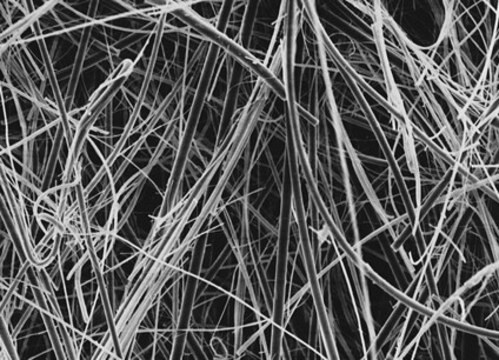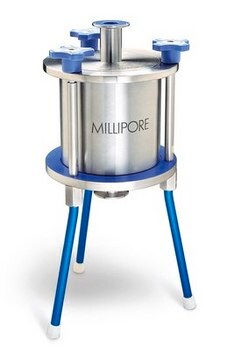추천 제품
material
glass fiber membrane
plain filter
white filter
설명
0.7 µm pore size, hydrophilic glass fiber, 142 mm diameter
무균
non-sterile
특징
hydrophilic
제조업체/상표
Millipore
파라미터
>300 mL/min-cm2 water flow rate (at 27 in Hg)
550 °C max. temp.
필터 직경
142 mm
두께
475 μm
공극 크기
0.7 μm pore size
90 % porosity
배송 상태
ambient
유사한 제품을 찾으십니까? 방문 제품 비교 안내
일반 설명
Millipore fibrous disc filters are available in a wide range of flow rates and throughput capacities. Our Glass Fiber filters are available with or without binder resins and can be sterilized by EO, gamma, or autoclave (121 °C at 1 bar).
Glass Fiber Filters with Binder Resin:
Millipore filters with binder resin have superior wet strength and are excellent for qualitative analysis and prefiltration, especially for heavily contaminated liquids. They are also widely used for clarification of aqueous solutions.
Type AP15
Type AP20
Type AP25
Glass Fiber Filters without Binder Resin:
The filters without binder resin retain their structural integrity without weight loss when heated up to 500 °C and can therefore be used in gravimetric analysis as well as for the filtration of hot gases.
Type APFA
Type APFB
Type APFC
Type APFD
Type APFF
Type AP40
Glass Fiber Filters with Binder Resin:
Millipore filters with binder resin have superior wet strength and are excellent for qualitative analysis and prefiltration, especially for heavily contaminated liquids. They are also widely used for clarification of aqueous solutions.
Type AP15
- Lowest dirt-holding capacity
- Recommended prefilter for 0.2 to 0.6 μm filters
Type AP20
- Lower retention, higher dirt-holding capacity than AP15 filters
- Recommended prefilter for 0.8 to 8.0 μm filters
- Use upstream to protect type AP15 filters
Type AP25
- Added thickness yields same retention and greater dirt-holding capacity as AP20
- Recommended prefilter for 0.9 to 8 μm filters, especially for proteinaceous and heavily contaminated liquids
- Use upstream to protect type AP15 filters
Glass Fiber Filters without Binder Resin:
The filters without binder resin retain their structural integrity without weight loss when heated up to 500 °C and can therefore be used in gravimetric analysis as well as for the filtration of hot gases.
Type APFA
- Retains fine particles with good efficiency, even at high flow rates
- Recommended for monitoring wastewater and collecting suspended particles in gases (e.g., fumes from chimneys)
- Use in biochemical applications (e.g., collection of cells and filtration of protein or nucleic acid precipitates)
Type APFB
- Higher mechanical strength when wet and greater loading capacity than type APFA filters
- Use for liquid clarification, quantification of solids in suspensions of fine particles, and scintillation counting
Type APFC
- Greater retention, especially for fine particulate and microorganism removal than type APFA filters
- Use for determining total suspended solids in drinking water
- Use for filtering proteins or nucleic acid TCA precipitates and for collecting cells and microorganisms
Type APFD
- Thick filter with high flow and low retention
- Use for clarifying suspensions containing particulates greater than 1.0 μm
Type APFF
- Use for filtering extremely fine precipitates such as protein, nucleic acids, or serum precipitates
- Recommended for USEPA method 1311 for TCLP analysis
Type AP40
- Recommended for Standard Methods Total Suspended Solids 2540D
- Recommended for USEPA method 1311 for TCLP analysis
- Maintains structural integrity without weight loss when ignited to 550 °C (1022 °F) after sample filtration
- Recommended for determining volatile suspended matter in wastewater and industrial effluents
애플리케이션
- Total Suspended Solids 2540D
- EPA method 1311 for TCLP analysis
- Determining volatile suspended matter in wastewater and industrial effluents
- Stack Testing for PFAS via OTM-45
특징 및 장점
- Recommended for Standard Methods Total Suspended Solids 2540D, Recommended for USEPA method 1311 for TCLP analysis.
- Compatible to heat when ignited to 550 °C (1022 °F) after sample filtration.
- For use in wastewater and industrial effluents for determining the volatile suspended matter.
시험 성적서(COA)
제품의 로트/배치 번호를 입력하여 시험 성적서(COA)을 검색하십시오. 로트 및 배치 번호는 제품 라벨에 있는 ‘로트’ 또는 ‘배치’라는 용어 뒤에서 찾을 수 있습니다.
자사의 과학자팀은 생명 과학, 재료 과학, 화학 합성, 크로마토그래피, 분석 및 기타 많은 영역을 포함한 모든 과학 분야에 경험이 있습니다..
고객지원팀으로 연락바랍니다.

